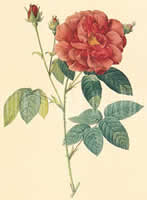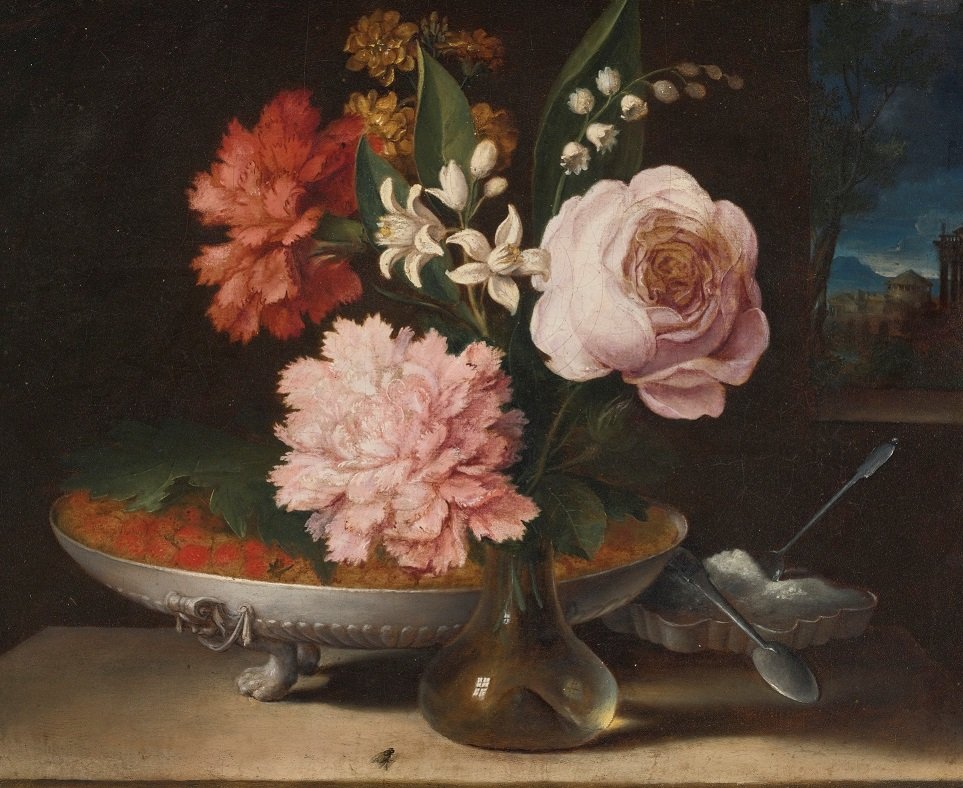A Potted History of Roses
by Chrys Stevenson BA (Hons I)If you’ve ever thought roses are too fragile, delicate or difficult to grow, you’ll be relieved to know they’re as tough as old boots. Given a modicum of care, your rose bush should outlive you. There’s an old saying, “You couldn’t kill it with an axe!” Well, we don’t suggest you take an axe to your rose bush but a rose, planted against the wall of Hildensheim Cathedral in Germany in 815 AD is still alive and thriving, despite the cathedral being bombed and destroyed in World War II. A friend refers to his wife’s blooms as ‘rose weeds’ because they’re so hardy and prolific.
Roses are great survivors. Scientists believe they come from a group of plants that lived 250 million years ago. Fossilised rose leaves dating back to the Palaeolithic era, 35-40 million years ago, have been found at various sites in Scandinavia, Europe and the Americas.
It’s often thought the rose is the traditional flower of Valentine’s day. But, originally, suitors offered smaller, locally sourced, simple flowers like violets. Once Valentine’s Day became hugely commercialised, and the demand for flowers exploded, sellers needed a hardy, but beautiful flower that could be grown en masse commercially, and could survive being boxed and transported over long distances. Roses were the perfect choice.
Roses have been travelling the globe for thousands of years. In the 24th century BC, the Mesopotamian King, Sargon of Akkad, led an expedition across the Taurus mountains. A catalogue of his loot includes grape-vines, figs and rose trees.
The strength and beauty of roses has been admired through the ages by men and women alike. Alexander the Great grew roses in his Cretan garden and is credited with introducing roses to Greece from his conquests in Persia.
Wild roses grew across the Americas, parts of Asia and Oceania and north west Africa. In the late 18th century, cultivated roses were introduced to Europe from China.
Roses have even travelled into space! The miniature rose, Overnight Scentsation was taken into space by researchers to help them understand the impact of low gravity on fragrance. The data was used to improve the fragrance of various consumer products.
The large number of petals seen on modern roses is a result of mutation and careful breeding. Originally, roses had only four or five petals. Cultivation started early, possibly around 5,000 years ago, by the Chinese and the Egyptians. Chinese roses were widely cultivated during the Han Dynasty (141-187 BC). But, even earlier, around 300BC, Theophrastus, the father of botany, identified roses with 12-20 petals.
French nurseryman, Jean-Baptiste André Guillot created the first modern rose with his hybrid tea rose “La France”. Today, rose breeding is a highly scientific endeavour which has yielded some spectacular results.
The world’s most costly rose was developed by British rosarian, David Austin, in 2006. It took Austin 15 years and $5 million to breed the delicate, apricot-coloured, “Juliet” rose. A rose by any other name may smell as sweet, but it wouldn’t cost as much!
The largest rose was bred by Nikita K Rulhoksoffski from California. It measured approximately 33 inches in diameter. Conversely, the buds of the smallest roses are the size of a grain of rice.
The first blue rose was cultivated in 2004 using genetic engineering and Dephinidin, a natural pigment found in a number of fruits, including the Cabernet grape. A black rose is famously grown in Turkey, but, although it appears pitch black, it is actually a very dark crimson.
But even some of the world’s oldest roses are spectacular and surprising.
The largest rose bush in the world is in Tombstone Arizona, planted in 1885. Grown over an arbor, it has a canopy covering 790 square metres (8,500 square feet). The circumference of its trunk is nearly 3.6 meters (12 feet), and it produces more than 200,000 blooms.
The world’s tallest rose bush stands over 7 metres (21 feet) tall. Imagine pruning it!
Roses have always been popular and versatile. For millennia, roses have been used for medicine, food, confetti, perfume, adornment, commemoration, symbolism and decoration.
In the Middle Ages, roses were grown by monks and apothecaries for their medicinal properties. Roman women believed rose petal poultices could banish wrinkles. Meanwhile, their husbands dropped rose petals into their wine to stave off drunkenness. How many roses might have been saved if the Roman men simply got so drunk they didn’t notice their wives’ wrinkles?
Romans also wore roses as necklaces or coronets. Rose petals were thrown as confetti to welcome home conquering heroes. And, if a meeting was secret – or sub rosa – a rose was hung on the door to remind participants that loose lips may secure their next appointment; with a lion in the Colosseum.
Rosa Gallica Officinalis, the apothecary rose, was first recorded in France in the 13th century. Click here to see link

These medicinal roses were used to make jellies, powders and oils for a variety of therapeutic purposes. The monks were on the right track. Modern-day pharmacological tests show extracts from R. damascene (the damask rose) have hypnotic, anticonvulsant, anti-depressant, anti-anxiety and analgesic effects. Roses. Not just beautiful, but good for you!
Roses have been used throughout history to add colour, flavour and decoration to foods and drinks. Here are some links to 15 recipes that use roses, from rose water, to rose tea and quail in rose petal sauce (made famous in the movie, Like Water for Chocolate). Click here to see link
The monks of San Lazzaro, an island in the Venetian lagoon, are known for their roses and rose petal jam, called Vartanush. A similar recipe can be found here. The secret is to massage the petals to extract the maximum colour and flavour. Click here to see link
No wonder, royalty and the very wealthy came to appreciate the beauty and practicality of roses, and began to plant rose gardens as symbols of status and wealth.
In the 19th century, Napoleon’s wife, Josephine, cultivated a large rose garden at the Chateau de Malmaison, near Paris. Josephine’s roses were famously painted by Pierre-Joseph Redouté whose masterwork Les Roses (1817) made him famous as ‘the man who painted roses’.
The world’s largest rose garden is in Cavriglia, Italy. The garden boasts over 7,500 varieties of rose. Then there are the farms in the Rose Valley of Bulgaria, famous for producing 85 per cent of the world’s rose oil. Rose oil, also known as ‘attar of roses’ or ‘rose otto’ was first made in Persia in the 10th century. True rose oil takes about 113 kg of petals to make just 2 tablespoons of oil. No wonder perfume is so expensive! By the 17th century, roses and rose water were considered so valuable they were used as legal tender and used for bartering. Sadly, that’s not going to work at Coles or Woolies today!
With roses known to symbolise both sorrow and royalty, it’s not surprising that a painting of roses was found in the tomb of the pharaoh, Thutmose IV, who ruled Egypt in the 14th century BC. Petrified rose wreaths have also been found in ancient Egyptian tombs.
That saucy minx, Cleopatra, is said to have covered the floor of her palace room 30cm (1 foot) deep in roses before receiving Mark Antony. Poor fellow never stood a chance. Cleopatra’s plan was to ensure that every time he smelled a rose, he would think of her.
Later, the rose came to symbolise the Virgin Mary. Two famous 15th century paintings show Mary in a a rose-grove. Later, in the 17th century, Dutch painter, Brueghel the Elder, depicted Mary surrounded by garlands of roses, fruit and other flowers.
The beauty of roses has long been celebrated in art. The first paintings of roses appeared in Asia around 3000 BC and in Greece around 1600 BC. Later, Greek floor mosaics show detailed garlands of roses with double blooms. A wall fresco, which miraculously survived the volcanic destruction of Pompeii, shows a double form of R. gallica growing in a garden.
Roses remain a popular subject for artists. American painter, Georgia O’Keeffe’s, rose paintings are often perceived as highly erotic because of their similarity to a certain region of the female anatomy, although O’Keeffe insisted the symbolism was completely unintended!
As one of the world’s oldest and most popular flowers, roses are rich with symbolism. Known as the ‘Queen of Flowers’ the rose has been used to symbolise love, beauty, purity, charm, innocence, sympathy, spring and the triumph of good over evil. But the complex rose is also a symbol of royalty, war, leadership, distinction, political factions, secrecy, sorrow and delusion. Add in the symbolism of colours, and you could assemble a bouquet to convey a secret message, as the Victorians loved to do, using the ‘language of flowers’.
The rose features heavily in Greek and Roman mythology. If you’ve ever been pricked by a rose thorn, blame Cupid! Legend has it, that when Cupid accidentally fired one of his love-arrows into a rose garden, the roses grew thorns. Bad shot, Cupid!
Have we convinced you to begin a love affair with roses? Truly! Despite being beautiful, delicate and fragrant, roses are the hardiest of plants and one of the most long-lasting cut flowers.
Whether you fancy yourself as Alexander the Great or Cleopatra, roses are a fascinating flower to grow or just enjoy as a cut flower for your home or special celebration. When you buy a rose, you’re buying 35 million years of history and a treasure-trove of symbolism.
And, as you plant and tend your roses, or simply enjoy their fragrance, you can sing any of over 4,000 songs dedicated to this amazing flower. Who can forget Bette Midler’s “The Rose”, Seal’s “Kiss from a Rose” or the beautiful Irish “Rose of Tralee”? Remember the country song “Rambling Rose”? Add a glass of champagne while you hum Edith Piaf’s haunting “La Vie En Rose”? And, while American singer Martina McBride may have ‘never promised you a rose garden,’ we can!
Chrys Stevenson, BA (Hons I)
Freelance writer, blogger, researcher, presenter

